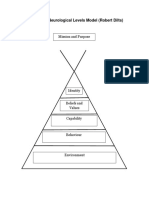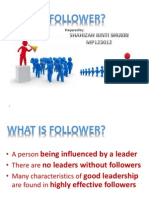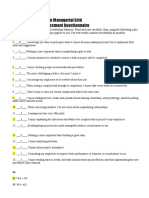Goal Setting Handouts Final
Goal Setting Handouts Final
Uploaded by
nikCopyright:
Available Formats
Goal Setting Handouts Final
Goal Setting Handouts Final
Uploaded by
nikOriginal Title
Copyright
Available Formats
Share this document
Did you find this document useful?
Is this content inappropriate?
Copyright:
Available Formats
Goal Setting Handouts Final
Goal Setting Handouts Final
Uploaded by
nikCopyright:
Available Formats
2
GOAL SETTING
WHY IS GOAL SETTING IMPORTANT?
Goals help describe success. People tend to maintain expectations, not surpass them. Thus,
expectations or goals should be challenging, yet within a person’s or group’s grasp. Goals are
outside an individual and sometimes referred to as “hoped for” rewards toward which motives
are directed. Goals create common tasks and processes for a group or individuals. By having
them, a group knows what it has to do and can work together on the goals.
Although goal setting is rewarding, some difficulties do exist:
It is sometimes difficult to quantify and qualify what goals or actions should be.
Goal setting takes time. Initially the members must be introduced to the process, develop
necessary skills, implement procedures and record evaluations.
Organizational goal setting can be difficult when trying to set goals that all members agree with
and will actively pursue.
What is goal?
A goal is an idea of the future or desired result that a person or a group of people
envisions, plans and commits to achieve
MISSION AND VISION
The vision statement focuses on tomorrow and what the organization wants to become. The
mission statement focuses on today and what the organization does. While companies
commonly use mission and vision statements interchangeably, it’s important to have both
Goal setting can:
serve as clear and specific delegations of responsibilities.
offer more diversity of services and programs by updating and improving old
programs and developing new ones.
identify both individual and organizational strengths and weaknesses.
allow clarification and/or development of an organization’s mission or philosophy.
focus your efforts in a consistent direction.
increase success because success can be defined as the achievement of a goal.
serve as self-motivators and energizers.
GOAL SETTING HANDOUTS | Casper Jay A. Roque
2
How does one develop effective goals?
Think about the future. If you are developing group goals, try to think of at least two
ways to describe the future through the group’s or member’s tasks or purposes.
Use your organization’s purposes statement. A purpose defines what the goals need
to be and then these goals can be adjusted each year.
Use the suggestions. By being open to feedback, one can get new ideas for goals.
The extent that individuals and groups perceive their own goals as being satisfied by
the accomplishment of organizational goals is the degree of integration of goal
Process for brainstorming goals:
Allow ideas to start goals.
Members should begin to talk about what they would like the group to accomplish.
Let every member take part in the brainstorming. This is important for morale and
cohesion. Also, members are more likely to support what they help create.
Unrealistic goals should not be weeded out until later.
When finalizing the goals, make sure that they are measurable.
After brainstorming, prioritize goals:
Place goals in order of importance. This can be difficult because each member has individual
ideas of what is important for the group. Break into small groups to prioritize goals
concerning different segments of the organization. Have members rank the goals on their
own and then share their ideas with the group to reach consensus. After goal setting,
develop plans to achieve the goals so they are more than nice words.
Types of Goals
Short-Term Goals Long-Term Goals
focus on performance focus on potential
require immediate action are reachable by small steps
accomplish tasks and complete projects build and develop individuals and
organizations
Develop an action plan:
If you have more than one objective, start with the one that the group considers the most
important or complex. Develop a detailed plan for fulfilling the objective by the target date.
Identify what information not already available is needed to meet that objective.
Identify the steps needed to accomplish the goal.
Put the steps in the order they need to be done.
Determine what individuals or groups in the organization will be involved in the
implementation of the plan. Then decide who will be responsible for what phases of the
action plan.
Set a deadline for each step.
Evaluate the goals or the people doing them periodically to check their progress and
make sure members are working to achieve them.
GOAL SETTING HANDOUTS | Casper Jay A. Roque
2
Conduct an evaluation of the goals by the end of the year. From the
evaluation, make recommendations for next year’s group.
When setting a goal it should be “SMART”
a. Short-term goal: A goal a person plans to achieve in the near future.
b. Long-term goal: A goal a person plans to achieve over a period of time.
The six steps of an action plan (a multi-step strategy to identify and achieve your goal.
a. STEP 1: Set a specific, realistic goal, and write it down.
i. Start your goal with I WILL.
b. STEP 2: List the steps you will take to reach your goal.
i. Look for ways you can break your long-term goal into short-term, smaller
goals.
c. STEP 3: Identify sources of help and support.
i. Who can help you? Who will support you?
d. STEP 4: Set a reasonable time frame for reaching your goal.
i. Write your goal date down.
e. STEP 5: Identify possible obstacles and evaluate your progress.
i. Don’t be afraid to adjust your goal if you are not progressing.
f. STEP 6: Reward yourself for achieving your goal.
i. Think of a way to celebrate the satisfaction of reaching a goal
GOAL SETTING HANDOUTS | Casper Jay A. Roque
2
GOAL SETTING HANDOUTS | Casper Jay A. Roque
2
In 1960’s, Edwin Locke put forward the Goal-setting theory of motivation. This theory states
that goal setting is essentially linked to task performance. It states that specific and challenging
goals along with appropriate feedback contribute to higher and better task performance.
In simple words, goals indicate and give direction to an employee about what needs to be done
and how much efforts are required to be put in.
The important features of goal-setting theory are as follows:
The willingness to work towards attainment of goal is main source of job motivation. Clear,
particular and difficult goals are greater motivating factors than easy, general and vague
goals.
Specific and clear goals lead to greater output and better performance. Unambiguous,
measurable and clear goals accompanied by a deadline for completion avoids
misunderstanding.
Goals should be realistic and challenging. This gives an individual a feeling of pride and
triumph when he attains them, and sets him up for attainment of next goal. The more
challenging the goal, the greater is the reward generally and the more is the passion for
achieving it.
Better and appropriate feedback of results directs the employee behaviour and contributes
to higher performance than absence of feedback. Feedback is a means of gaining
reputation, making clarifications and regulating goal difficulties. It helps employees to work
with more involvement and leads to greater job satisfaction.
Employees’ participation in goal is not always desirable.
Participation of setting goal, however, makes goal more acceptable and leads to more
involvement.
Goal setting theory has certain eventualities such as:
a. Self-efficiency- Self-efficiency is the individual’s self-confidence and faith that he has
potential of performing the task. Higher the level of self-efficiency, greater will be
the efforts put in by the individual when they face challenging tasks. While, lower
the level of self-efficiency, less will be the efforts put in by the individual or he might
even quit while meeting challenges.
b. Goal commitment- Goal setting theory assumes that the individual is committed to
the goal and will not leave the goal. The goal commitment is dependent on the
following factors:
i. Goals are made open, known and broadcasted.
ii. Goals should be set-self by individual rather than designated.
iii. Individual’s set goals should be consistent with the organizational goals and
vision.
GOAL SETTING HANDOUTS | Casper Jay A. Roque
2
Advantages of Goal Setting Theory
Goal setting theory is a technique used to raise incentives for employees to complete
work quickly and effectively.
Goal setting leads to better performance by increasing motivation and efforts, but also
through increasing and improving the feedback quality.
Limitations of Goal Setting Theory
At times, the organizational goals are in conflict with the managerial goals. Goal conflict
has a detrimental effect on the performance if it motivates incompatible action drift.
Very difficult and complex goals stimulate riskier behaviour.
If the employee lacks skills and competencies to perform actions essential for goal, then
the goal-setting can fail and lead to undermining of performance.
There is no evidence to prove that goal-setting improves job satisfaction.
How to Set Goals
1. Setting Clear Goals
When your goals are clear, you know what you're trying to achieve. You can also measure
results accurately, and you know which behaviors to reward. This is why SMART is such a
useful mnemonic.
However, when a goal is vague – or when you express it as a general instruction like "take
initiative" – it isn't easy to measure, and it isn't motivating. You may not even know you've
achieved it!
Personal Goal Setting Team Goal Setting
Write your goal down and be as Set clear goals that use specific and
detailed as possible. Use SMART, measurable standards. For example,
and consider putting your goal "reduce job turnover by 15 percent."
into the form of a personal Write down the metrics that you'll
mission statement for added use to measure your team members'
clarity. success. Be as specific as possible, and
Think about how you'll measure make sure that everyone on your
your success toward this goal. team understands how you'll measure
What specific metrics will you success.
use?
Once you've set your goal,
examine how it makes you feel.
GOAL SETTING HANDOUTS | Casper Jay A. Roque
2
Personal Goal Setting Team Goal Setting
Are you excited? Does the
challenge motivate you? If you
2. Setting Challenging Goals
People are often motivated by challenging goals, however it's important not to set a goal
that is so challenging it can't be achieved.
How to Set Challenging Goals
Personal Goal Setting Team Goal Setting
Look at your goal. Is it
challenging enough to spark your
interest?
Develop self-discipline , so that
you have the persistence to work
through problems. Use the Inverted-U model to find the
Identify ways that you can best balance between pressure and
reward yourself when you make performance when you set goals.
progress. Incremental rewards Think about how you'll reward team
for reaching specific milestones members when they achieve
will motivate you to work challenging goals.
through challenging tasks. If possible, create some friendly
Before taking on a major goal, competition between team members
research it thoroughly. This will or departments. Competition can
help you be realistic. encourage people to work harder.
3. Securing Team Commitment
To be effective, your team must understand and agree to the goals – team members are
more likely to "buy into" a goal if they have been involved in setting it.
This doesn't mean that you have to negotiate every goal with your team members and
secure their approval. They're likely to commit to it as long as they believe that the goal is
achievable, it is consistent with the company's ambitions, and the person assigning it is
credible.
How to Secure Commitment to Goals
Personal Goal Setting Team Goal Setting
Stay committed by Allow team members to set their own
using visualization techniques to goals. This will increase their sense of
imagine how your life will look commitment and empowerment.
once you've achieved your goal. Use Management by Objectives to
GOAL SETTING HANDOUTS | Casper Jay A. Roque
2
Personal Goal Setting Team Goal Setting
Create a treasure map to remind ensure that your team's goals align
yourself why you should work with the
hard. Visual representations of .
4. Gaining Feedback
In addition to selecting the right goals, you should also listen to feedback, so that you can
gauge how well you and your team are progressing.
Feedback gives you the opportunity to clarify people's expectations and adjust the difficulty
of their goals.
Keep in mind that feedback doesn't have to come from other people. You can check how
well you're doing by simply measuring your own progress.
How to Give Feedback on Goals
Personal Goal Setting Team Goal Setting
Schedule time once a week to
analyze your progress and
accomplishments. Look at what
has and hasn't worked, and make
adjustments along the way.
Learn how to ask for
feedback on your progress from
others.
Use technology to track and Learn how to give your team
measure your progress. Apps members feedback that's objective,
like Lift are a good place to start. useful and positive.
Measure progress by breaking Create a timetable to schedule regular
difficult or large goals down into feedback for your team.
smaller chunks, and seek Use the Stop – Keep Doing –
feedback when you reach each Start model for quick feedback
milestone. sessions.
GOAL SETTING HANDOUTS | Casper Jay A. Roque
2
5. Considering Task Complexity
Take special care to ensure that work doesn't become too overwhelming when goals or
assignments are highly complex.
People who work in complicated and demanding roles can often push themselves too hard,
if they don't take account of the complexity of the task.
How to Set Complex and Challenging Goals
Personal Goal Setting Team Goal Setting
Give yourself plenty of time to
accomplish complex goals. Set
deadlines that apply an
appropriate amount of
pressure, while still being
achievable.
If you start to
feel stressed about meeting Your team members might need
your goals, they might be too additional training before they work
complex or unrealistic. Reassess toward their goal. Give everyone
both of these areas and modify a training needs assessment to
your goals if necessary. identify any knowledge or skills gaps.
Break large, complex goals If you notice that any team members
down into smaller sub-goals. are overwhelmed, consider putting
This will stop you feeling them into
overwhelmed, and it will make a coaching or mentoring relationship
it easier to stay motivated. with a more experienced colleague.
GOAL SETTING HANDOUTS | Casper Jay A. Roque
You might also like
- ATDC2 English 9 Unchanging Values in The VUCA WorldDocument31 pagesATDC2 English 9 Unchanging Values in The VUCA Worldherz eli100% (6)
- Essentials of Polymer Science and Engineering by Paul C. Painter & Michael M. Coleman PDFDocument530 pagesEssentials of Polymer Science and Engineering by Paul C. Painter & Michael M. Coleman PDFPrasanna Kumar S Mural86% (7)
- Concrete Institute of Australia - Recomended Practice - Z40 Super Workable ConcreteDocument30 pagesConcrete Institute of Australia - Recomended Practice - Z40 Super Workable Concretetim100% (3)
- Team Aspiration Goal Creation TemplateDocument3 pagesTeam Aspiration Goal Creation TemplateDeepak Kr KanodiaNo ratings yet
- Tutorial Questions-Week 1-6Document9 pagesTutorial Questions-Week 1-6Vincent KohNo ratings yet
- Goal Setting Is A Powerful Way of Motivating PeopleDocument4 pagesGoal Setting Is A Powerful Way of Motivating PeopleYogi Kumar100% (2)
- Personal Development Planning and Career Planning FinalDocument19 pagesPersonal Development Planning and Career Planning FinalDanar AdityaNo ratings yet
- LO1 Growth MindsetDocument28 pagesLO1 Growth MindsetLearn EverythingNo ratings yet
- Summary 2 TCH Story PitchDocument2 pagesSummary 2 TCH Story PitchVasanth RajaNo ratings yet
- Time Management: Good Time Management Is Essential For Coping With The Pressures of Modern Life Without Too Much StressDocument2 pagesTime Management: Good Time Management Is Essential For Coping With The Pressures of Modern Life Without Too Much Stressmaria elviraNo ratings yet
- ScoreboardDocument2 pagesScoreboardKyrieNo ratings yet
- Time Management: Until We Can Manage Time, We Can Manage Nothing Else. Peter DruckerDocument27 pagesTime Management: Until We Can Manage Time, We Can Manage Nothing Else. Peter DruckerSakshi BansalNo ratings yet
- HBS107 AT1 Skills AuditDocument5 pagesHBS107 AT1 Skills Auditcaleb mwanziaNo ratings yet
- The Seven Habits of Highly Effective People: Habit 1 - Be ProactiveDocument2 pagesThe Seven Habits of Highly Effective People: Habit 1 - Be ProactiveTasadduq hussainNo ratings yet
- Week 3 - Communication SkillsDocument28 pagesWeek 3 - Communication SkillsIodanutzs UkNo ratings yet
- Session 17: The Neurological Levels Model (Robert Dilts) : Mission and PurposeDocument6 pagesSession 17: The Neurological Levels Model (Robert Dilts) : Mission and Purposevss bruceNo ratings yet
- How To Develop A Mentoring ProgramDocument26 pagesHow To Develop A Mentoring ProgramChristian ElongueNo ratings yet
- For Coaches and Clients Kickstarter Pack For A Successful Experience atDocument22 pagesFor Coaches and Clients Kickstarter Pack For A Successful Experience atRanaNo ratings yet
- Personal EffectivenessDocument11 pagesPersonal EffectivenessAhmed ShafiqueNo ratings yet
- The Five Practices of LeadershipDocument2 pagesThe Five Practices of Leadershipaafaque shaikhNo ratings yet
- Human Resources ManagementDocument87 pagesHuman Resources ManagementrvmenesNo ratings yet
- Goal Setting WorksheetDocument3 pagesGoal Setting Worksheetksudhakar09No ratings yet
- Career Exploration Interview PackageDocument11 pagesCareer Exploration Interview Packageapi-403436791No ratings yet
- Leader Followers RelationshipDocument10 pagesLeader Followers RelationshipLa JiejaNo ratings yet
- Job Aid Effective Delegation WorksheetDocument19 pagesJob Aid Effective Delegation WorksheetCosmin Corlatescu100% (2)
- Reflection SheetDocument13 pagesReflection SheethfjdprjjhxNo ratings yet
- Effective Goal SettingDocument32 pagesEffective Goal SettingLancemachang EugenioNo ratings yet
- Personal Development Plan TemplateDocument2 pagesPersonal Development Plan TemplateAmanpreet singhNo ratings yet
- 25 Ways To Develop A Growth MindsetDocument3 pages25 Ways To Develop A Growth MindsetHibiscos100% (2)
- Situational Leadership and Performance CoachingDocument7 pagesSituational Leadership and Performance CoachingloraineNo ratings yet
- Hogan AssessmentsDocument1 pageHogan Assessmentsapexes-spiral0eNo ratings yet
- Career Management Skills WorkshopDocument29 pagesCareer Management Skills WorkshopTristram HooleyNo ratings yet
- Strengthsfinder Hakes Job Transition1Document22 pagesStrengthsfinder Hakes Job Transition1alin_titocNo ratings yet
- Growth MindsetDocument26 pagesGrowth MindsetMariel ObradoNo ratings yet
- Peer To Peer Coaching Final Draft - OYE TanzaniaDocument15 pagesPeer To Peer Coaching Final Draft - OYE TanzaniaGetachew HussenNo ratings yet
- Participants WorkbookDocument6 pagesParticipants WorkbookJoshua johnNo ratings yet
- The Blake and Mouton Managerial GridDocument2 pagesThe Blake and Mouton Managerial GridTalentNo ratings yet
- Communication and LeadershipDocument76 pagesCommunication and LeadershipsachinNo ratings yet
- Strategy Template: Risk CommunicationDocument9 pagesStrategy Template: Risk CommunicationZenard de la Cruz0% (1)
- Qualities of A LeaderDocument16 pagesQualities of A LeaderNjine PatrickNo ratings yet
- Week 6 Stress and Wellbeing at Work - BB LearnDocument23 pagesWeek 6 Stress and Wellbeing at Work - BB LearnTaimoor BaigNo ratings yet
- Responsibility VS AccountabilityDocument5 pagesResponsibility VS AccountabilityNisith SahooNo ratings yet
- Be S.M.a.R.T. With Your GoalsDocument4 pagesBe S.M.a.R.T. With Your GoalsajismandegarNo ratings yet
- Own Your Life WorksheetDocument11 pagesOwn Your Life Worksheetxt4c2vsjkdNo ratings yet
- DelegationDocument4 pagesDelegationalwil144548No ratings yet
- Establishing Your Career Goals & MotivationsDocument5 pagesEstablishing Your Career Goals & Motivationsrecoverybuck112100% (1)
- Best-Practices Leadership: Business Management DailyDocument16 pagesBest-Practices Leadership: Business Management DailyvgheroldNo ratings yet
- Mindset QuizDocument4 pagesMindset QuizMara NagyNo ratings yet
- Instant Results Lifelong Clients ManualDocument58 pagesInstant Results Lifelong Clients ManualAngel OrtegaNo ratings yet
- Business Analytical ToolsDocument13 pagesBusiness Analytical ToolsGaurav Dhaka100% (1)
- Career Development Plan: Employee Name: Current Role: Career or Job Interest: Date of PlanDocument3 pagesCareer Development Plan: Employee Name: Current Role: Career or Job Interest: Date of PlanArun KrishnamurthyNo ratings yet
- Collaborative TeamingDocument35 pagesCollaborative TeamingmochjodhyNo ratings yet
- Learning Team Drama - Group CaseDocument5 pagesLearning Team Drama - Group CaseMarita GenebashviliNo ratings yet
- Leading Team - Team Presentation-30.6.2024 Updated SlideDocument40 pagesLeading Team - Team Presentation-30.6.2024 Updated Slidenyanlinn aungNo ratings yet
- Session 2 Planning & Goal Setting Ch05-St VersionDocument32 pagesSession 2 Planning & Goal Setting Ch05-St VersionAhmed ZidanNo ratings yet
- Time Management: Biju SomanDocument40 pagesTime Management: Biju SomanAnenas BalanNo ratings yet
- Daily Lesson Log in Senior High Department: FEB 18-22, 2019 Day 1 Day 2 Day 3 Day 4 I - ObjectivesDocument6 pagesDaily Lesson Log in Senior High Department: FEB 18-22, 2019 Day 1 Day 2 Day 3 Day 4 I - ObjectivesjoellynNo ratings yet
- Time Management: Presented To AjayrajwilsonDocument11 pagesTime Management: Presented To AjayrajwilsonsonusumitraNo ratings yet
- Career PathDocument2 pagesCareer Pathapi-558219272No ratings yet
- Employee Engagement and MotivationDocument23 pagesEmployee Engagement and Motivationvivekact100% (1)
- Leadership & Emotional IntelligenceDocument51 pagesLeadership & Emotional IntelligenceNitu RevankarNo ratings yet
- Seven Communication Mistakes Managers Make: by Stever RobbinsDocument3 pagesSeven Communication Mistakes Managers Make: by Stever Robbins25526No ratings yet
- The Front-line Manager: Practical Advice for SuccessFrom EverandThe Front-line Manager: Practical Advice for SuccessRating: 5 out of 5 stars5/5 (1)
- Assurance Standards B: Subsequent EventsDocument14 pagesAssurance Standards B: Subsequent EventsnikNo ratings yet
- Standards B: Audit SamplingDocument20 pagesStandards B: Audit SamplingnikNo ratings yet
- Surance Standards B: Initial Audit Engagements - Opening BalancesDocument15 pagesSurance Standards B: Initial Audit Engagements - Opening BalancesnikNo ratings yet
- Audit Evidence - Specific Considerations For Selected Items: Philippine Standard On Auditing 501 (Redrafted)Document13 pagesAudit Evidence - Specific Considerations For Selected Items: Philippine Standard On Auditing 501 (Redrafted)nikNo ratings yet
- C11 Audit Reports On FS PDFDocument22 pagesC11 Audit Reports On FS PDFnikNo ratings yet
- Other PSAs and PAPSsDocument7 pagesOther PSAs and PAPSsnikNo ratings yet
- Purchasing Power Parity (PPP) Is A: Acapulco) WereDocument4 pagesPurchasing Power Parity (PPP) Is A: Acapulco) WerenikNo ratings yet
- ConclusionDocument1 pageConclusionnikNo ratings yet
- TBCH03Document10 pagesTBCH03PatrickBeronaNo ratings yet
- C10 Completing The Audit PDFDocument15 pagesC10 Completing The Audit PDFnikNo ratings yet
- MS Quiz 4Document2 pagesMS Quiz 4nikNo ratings yet
- Ce Standards B: Agreeing The Terms of Audit EngagementsDocument40 pagesCe Standards B: Agreeing The Terms of Audit EngagementsnikNo ratings yet
- Quality Control For An Audit of Financial Statements: Philippine Standard On Auditing 220 (Redrafted)Document21 pagesQuality Control For An Audit of Financial Statements: Philippine Standard On Auditing 220 (Redrafted)nikNo ratings yet
- Quality Control For Firms That Perform Audits and Reviews of Financial Statements, and Other Assurance and Related Services Engagements)Document40 pagesQuality Control For Firms That Perform Audits and Reviews of Financial Statements, and Other Assurance and Related Services Engagements)nikNo ratings yet
- Foreign Currency PDFDocument2 pagesForeign Currency PDFnikNo ratings yet
- PSA 705 (Revised) - CleanDocument25 pagesPSA 705 (Revised) - CleannikNo ratings yet
- What Is The Performing StageDocument1 pageWhat Is The Performing StagenikNo ratings yet
- Practical Accounting 1 Theory of AccountsDocument1 pagePractical Accounting 1 Theory of AccountsnikNo ratings yet
- Hbointro and BackgroundDocument9 pagesHbointro and BackgroundnikNo ratings yet
- The Auditor'S Report On General Purpose Financial Statements Prepared in Accordance With A Philippine Financial Reporting Framework Other Than PfrsDocument7 pagesThe Auditor'S Report On General Purpose Financial Statements Prepared in Accordance With A Philippine Financial Reporting Framework Other Than PfrsnikNo ratings yet
- Auditing Standards and Practices Council: Philippine Auditing Practice Statement 1000 Inter-Bank Confirmation ProceduresDocument12 pagesAuditing Standards and Practices Council: Philippine Auditing Practice Statement 1000 Inter-Bank Confirmation ProceduresnikNo ratings yet
- Auditing Standards and Practices CouncilDocument30 pagesAuditing Standards and Practices CouncilnikNo ratings yet
- Horizontal HachuresDocument4 pagesHorizontal HachuresWody AnitaNo ratings yet
- CFC - 9 Skills With BriefDocument3 pagesCFC - 9 Skills With BriefShehzad QureshiNo ratings yet
- Research Papers On Digital Image Processing 2012Document8 pagesResearch Papers On Digital Image Processing 2012fys5ehgs100% (1)
- Social & Ethical AccountingDocument12 pagesSocial & Ethical AccountingfadiahrianusNo ratings yet
- For Trends - Week2Document25 pagesFor Trends - Week2jayroldparcedeNo ratings yet
- Review XAVIER SABATIER. Les Formes Du Realisme MathematiqueDocument9 pagesReview XAVIER SABATIER. Les Formes Du Realisme MathematiqueIntinionNo ratings yet
- A Guide To Depth Studies October 2017 1 of 8Document8 pagesA Guide To Depth Studies October 2017 1 of 8conchoNo ratings yet
- KFW - Emission Reduction in CitiesDocument2 pagesKFW - Emission Reduction in CitiesSamuel HutabaratNo ratings yet
- Germán Campos Muñoz (2021) - The Classics in South America Five Case StudiesDocument273 pagesGermán Campos Muñoz (2021) - The Classics in South America Five Case StudiesdserranolozanoNo ratings yet
- Is5312 Week10-V2Document51 pagesIs5312 Week10-V2lengbiao111No ratings yet
- PVT VariationsDocument17 pagesPVT VariationsnarendraNo ratings yet
- Physics Learning MaterialDocument128 pagesPhysics Learning MaterialMukesh SrivastavaNo ratings yet
- BIOINFORMATICSDocument4 pagesBIOINFORMATICSCecilia MukototsiNo ratings yet
- Assessment Section 3.2Document10 pagesAssessment Section 3.2ROSE MARIE REVILLANo ratings yet
- أخلاقيات الذكاء الإصطناعيDocument21 pagesأخلاقيات الذكاء الإصطناعيمحمد سامي أبوعصرNo ratings yet
- Romblon PIR Report 1st Quarter 2023 - EnhancedDocument50 pagesRomblon PIR Report 1st Quarter 2023 - EnhancedJonathan LilangNo ratings yet
- 2024-MQ Merit list-CE-ITDocument97 pages2024-MQ Merit list-CE-ITJenish patelNo ratings yet
- Oskar Vallhagen.: Photon RocĸetDocument1 pageOskar Vallhagen.: Photon RocĸetDiana PonceNo ratings yet
- "Introduction To Mechatronics": Mechatronics PDB 26104 Jupry Hamzah EmailDocument13 pages"Introduction To Mechatronics": Mechatronics PDB 26104 Jupry Hamzah EmailIzzat AzmiNo ratings yet
- Reading Practice Cambridge 17 Test 3Document13 pagesReading Practice Cambridge 17 Test 3sidikNo ratings yet
- PST FuncDocument73 pagesPST Funco0obavuongo0oNo ratings yet
- Project Management Lecturenote 20211 C1 FundamentalDocument28 pagesProject Management Lecturenote 20211 C1 FundamentalTâm ĐặngNo ratings yet
- CMC Vellore Summer Admission Bulletin 2020 Revised 16 Nov 2020Document58 pagesCMC Vellore Summer Admission Bulletin 2020 Revised 16 Nov 2020Allen ChrysoNo ratings yet
- Group Dynamics PDFDocument14 pagesGroup Dynamics PDFHike HimalayasNo ratings yet
- Cobalt ProfileDocument22 pagesCobalt ProfileMukundan ParavasthuNo ratings yet
- Design of Heat Recovery System For Dye Effluent in Textile IndustriesDocument5 pagesDesign of Heat Recovery System For Dye Effluent in Textile IndustriesdevilnishNo ratings yet















































































































